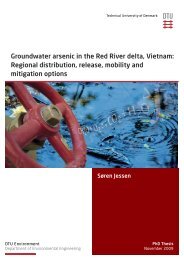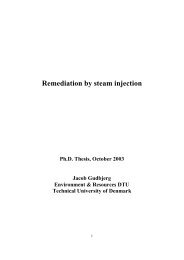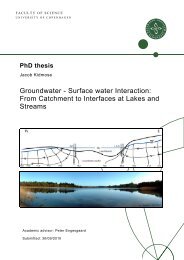Download PhD Thesis - Fiva
Download PhD Thesis - Fiva
Download PhD Thesis - Fiva
You also want an ePaper? Increase the reach of your titles
YUMPU automatically turns print PDFs into web optimized ePapers that Google loves.
2.3.1. Carbohydrate supply − source activity<br />
During normal ovary and seed development, sucrose is delivered via the phloem from<br />
source leaves to the developing sinks (fruits/seeds) to support the growth of these organs<br />
(Patrick, 1988). Manipulation studies involving altered radiation intensities (Schou et al.,<br />
1978; Egli and Yu, 1991; Andrade et al., 2000), elevated atmospheric CO2 (Hardman and<br />
Brun, 1971; Mitchell et al., 1996), defoliation (Board and Tan, 1995), and supplement with<br />
various levels of sucrose (Lee et al., 1989; Aloni et al., 1997; Abdin et al., 1998) have<br />
demonstrated that there is a close linear relationship between the rate of assimilate supply<br />
and the number of fruit/seed per unit area across several crop species, including soybeans.<br />
It is well known that the export rate of sucrose from source (leaves) to sink (fruits/seeds)<br />
organs is dependent on the current photosynthetic rate and the concentration of sucrose in<br />
the leaves (Fader and Koller, 1983; Huber et al., 1984; Grodzinski et al., 1998; Komor,<br />
2000). The export rate of sucrose could be expressed as a positive linear function to the<br />
photosynthetic rate and the concentration of sucrose in the leaves (Fader and Koller, 1983;<br />
Huber et al., 1984). Drought stress decreases photosynthetic rate and that will apparently<br />
decrease the export rate (Huber et al., 1984). Also, drought stress may disrupt carbohydrate<br />
metabolism in the leaves. Several authors have shown that drought stress decreased<br />
sucrose concentrations in the leaves, and that was presumably due to an increased activity<br />
of acid invertase as induced by drought stress (Pelleschi et al., 1997; Kim et al., 2000).<br />
Both a low rate of photosynthesis and a low sucrose concentration in the leaves may cause<br />
a decreased rate of sucrose export to the sink organs, and thereby affect the reproductive<br />
development. As the plant growth rate is tightly correlated with the photosynthetic rate of<br />
the canopy, it is not surprising that a single linear relationship between total seed number<br />
and the plant growth rate was obtained from field peas across various cultivars, different<br />
water and temperature regimes (Guilioni et al., 2003). A fundamental role of carbohydrate<br />
supply in determining kernel set has been proposed in drought-stressed maize plants<br />
(Schussler and Westgate, 1994; 1995; Setter et al., 2001; Zinselmeier et al., 1995a,b;<br />
1999). Under non-stress conditions, concurrent photosynthate is the predominant supplier<br />
of carbohydrates for ovary growth (Fig. 7A). At mild drought stress, concurrent<br />
photosynthate flux decreases significantly and ovary growth is largely dependent on<br />
carbohydrates supply from reserves (Fig. 7B). As the stress becomes more severe,<br />
assimilate supply from photosynthesis is totally inhibited and only a very small amount of<br />
reserve carbohydrate is available, this causes carbohydrate deprivation and eventually<br />
12





